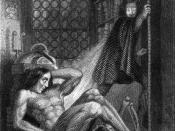How does Mary Shelley shape our response to ideas about monstrosity in Frankenstein?
Monstrosity is a key theme raised in Mary Shelley's Frankenstein. Our responses towards monstrosity include sympathy towards the creature, spite towards the creator, questioning of who actually is the real monster (whether it be the creature, or Frankenstein himself) and the consideration of the Rousseau's idea of human's being born innocent until corrupted (turned monstrous) by society's ideals. Mary Shelley has effectively shaped our responses towards monstrosity in this way by using several techniques. These techniques include the three level narrative structure, which is linked with the personalities and experiences of the characters, symbolism and imagery and tone/word choice. The three level narrative structure offers us a greater range of perspectives rather than just one, providing us with greater insight into the experiences and personalities of the characters while symbolism and imagery arouses our emotions by creating visual images of certain ideas relating to monstrosity.
Tone/word choice dramatises the characters and the narrative and again, causes the reader to respond in a particular way towards particular characters and issues raised. Mary Shelley has effectively used all these techniques to shape our responses towards the ideas relating to monstrosity.
Firstly, Shelley uses the technique of the three level narrative structure, which offers us three different perspectives- Frankenstein's, Walton's and the creature's. This enables us to have greater insight into the inner experiences of the characters, which leads to further development in the attitudes in which we hold towards the idea of monstrosity. Shelley includes the story of Victor, the creator, and the story of the creature, the created, which emphasises the contrasts between their personalities and their experiences. This offers us two entirely different views, which in turn, causes us to have two entirely different responses...



Great point
Really good, but I think you could have been brought some others quotes from the book. Despite that, it's a really good essay, and the subject is intense and told the truth all the time.
0 out of 0 people found this comment useful.